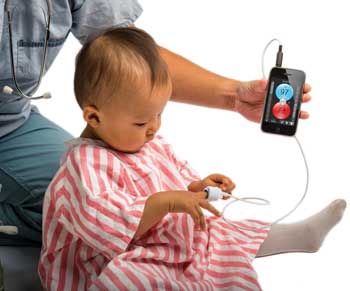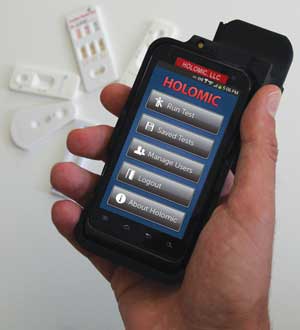
Smartphones Set to Revolutionize the Medical World …
… but companies developing portable diagnostic devices for use in underserved settings must first consider a host of practical factors.
The smartphone is an obvious choice for bringing diagnostic and other health care options to the developing world, rural areas and other underserved places. The technology offers the necessary computing power, storage and connectivity in a mobile technology that is already pervasive, even in regions that seem isolated.
And the need is very real. For example, more than 70,000 operating rooms around the world do not have pulse oximeters. Unsurprisingly, perhaps, most of these are in the developing world: 41 percent of operating rooms in South America, 49 percent in South Asia and 70 percent in sub-Saharan Africa do not have adequate monitoring of blood oxygen levels reaching the brain.
As for its impact on anesthesia-related injury, “The consequences of this are staggering,” said Dr. Loki Jörgenson, chief technology officer at LionsGate Technologies of Vancouver, British Columbia, Canada. Tens of thousands of lives are lost every year because doctors are not aware of oxygen levels during surgery. Anesthesia death rates in the developing world are up to 1000 times higher than in the developed world.
On an even more catastrophic scale, acute respiratory infections in young children – such as pneumonia, asthma and bronchiolitis – are a leading cause of death around the developing world. In 2011, more than 1.3 million children under the age of 5 died of related infections. Annually, more than 150 million cases reach “severe disease” state and require hospitalization. However, more than 80 percent of the deaths occur outside of hospitals, largely due to the lack of critical tools and skills to identify key risk factors in the development of severe pneumonia.
To address these significant global health issues, LionsGate has developed a device it calls the Phone Oximeter. It serves the same function as the conventional pulse oximeter but uses only a low-cost finger sensor running through the audio port of a smartphone. The device takes advantage of a proprietary analog-to-digital AC-coupled bridging framework called the Vital Signs DSP to enable mobile-based, software-defined sensing. This helps to drive down the cost of the technology, and thus to facilitate broader implementation in the developing world, where the “massive penetration” of smartphone technology will be integral to the success of the Phone Oximeter, Jörgenson said.

LionsGate Technologies has developed a device called a Phone Oximeter to address global
health needs. The device provides the same functionality as a conventional pulse oximeter using
only a low-cost finger sensor and a smartphone. This image shows a research prototype of the device. Courtesy of LionsGate Technologies.
But there’s more to it than that. Beyond the technological considerations, companies face a host of challenges in developing portable diagnostic devices for use in resource-limited settings.
Not least of these: the question of funding. Raising money to devise a technology intended solely for the developing world can be difficult. It’s not entirely clear from where the return on investment will come: There may be a demand for the technology, but is there a market? Who will actually pay for the technology?
For this reason, some companies are looking for ways to leverage the technology, to develop it for other applications – including point-of-care and home-testing applications – that have a clearer path to commercialization. “To minimize their own risks,” said Dr. Aydogan Ozcan, a UCLA professor who has introduced a range of portable imaging and sensing devices for mobile health applications, “they’re first targeting markets in the US, Europe or Japan and then focusing on another version of the same device for less-well-understood markets.”

This digital “universal” reader from Dr. Aydogan Ozcan’s lab at UCLA – consisting of only an inexpensive lens, two AAA batteries and three LED arrays – clips onto a smartphone and can be used for all rapid diagnostic tests. Courtesy of Aydogan Ozcan.
At the same time, we are seeing considerable growth in “social impact investment,” where the return is measured not only in terms of profit, but also in terms of the number of lives saved, the number of people reached, costs mitigated and so on. The types of investment can include grants and endowment capital, private equity and venture capital, and the social impact bond, a funding mechanism where investors are repaid only if particular social outcomes are achieved.
Social impact investment can provide a host of funding opportunities for companies developing mobile health technologies, but the social impact description can apply more broadly as well. Increasing numbers of companies – yes, even pure-profit companies – are getting in on the game, focusing on social outcomes as well as the financial return.
“It’s not a giveaway or solely an act of charity,” Jörgenson said, “but rather a viable business opportunity. A well-positioned company can act critically and still be able to deliver a technology that otherwise would not be available or would simply cost too much.”
Also posing major challenges are the regulatory requirements that might or might not apply to cellphone-based devices.
“The regulatory burdens in this country are substantial,” said Neven Karlovac, CEO of Holomic LLC, which is commercializing technologies invented by Ozcan’s research group at UCLA. “They are costly and time-consuming, and there is no way around them in the medical field. Plus, with mobile health or digital health and especially with telemedicine, there is the additional difficulty that the FDA is not certain how to handle these [new technologies].”
Questions, concerns
Much of the ambiguity stems from the question of what exactly requires regulation. With respect to mobile medical apps, for example, the FDA issued draft guidance two years ago but, as of the time of writing, had yet to provide the final guidelines.
The uncertainty also extends to the smartphone platform and the nature of mobile apps: How should mobile apps be regulated? What roles do the FDA and other regulatory bodies play in the development of the rapidly growing mHealth (mobile health) sector? How can lay involvement in disease self-diagnosis and management be encouraged and supported without introducing new risks?
Until recently, very little regulation was imposed on the rapidly growing medical-app industry. What apps should be regulated and why depend on certain key factors.

Holomic introduced its HRDR-200, the latest version of its smartphone-based rapid diagnostic reader, at the American Association of Clinical Chemistry (AACC) meeting in July/August of this year. The reader weighs less than 8 oz and thus could serve a range of mobile health applications. At the same time, the smartphone platform helps to make it and similar devices more affordable than conventional readers. Courtesy of Holomic LLC.
“It becomes a question of context and usage,” Jörgenson said. “How is it being used? Is it invasive or noninvasive? Is the health care worker making decisions based on what it does? Are they using it to diagnose, predict, define?”
And the questions don’t stop there. Questions and additional complications can arise from the very short life cycle of the phone: Will developers need to obtain clearance for each new generation of phone used with their devices – or for the combination of phone and add-on in question, even if each component on its own has received FDA approval?
And even beyond these questions are concerns about how mobile health will fit into the existing infrastructure of developing-world countries, and about whether sociocultural obstacles of any sort might exist (see sidebar). “You can’t just parachute in a technology and expect people to adopt it, or even understand what it means to adopt it,” Jörgenson said. “You have to make sure that what you’re bringing to bear [in terms of the technology] doesn’t have any roadblocks to implementation.”
In this sense, of course, the necessary steps for entering developing-world markets are largely the same as for entering markets in the developed world. Companies must do their research, both to determine the feasibility of commercializing a technology and to define the best path toward doing so.
A ready supply of smartphones
One of the myriad challenges faced by developers of smartphone-based imaging devices is the very short life cycle of the phones themselves.
Dr. Aydogan Ozcan has an idea as to how to address this challenge: encouraging development of a derivative smartphone market. With respect to smartphones, the motivation is entirely different with medical device companies than with consumers: It’s not nearly as often driven by performance or novelty. So there could be an excellent business opportunity to provide device designers and diagnostics companies with a supply of reliable, inexpensive, older-generation phones.
A company could invest in a large supply of a particular phone, Ozcan said, and – based on sales predictions – sign agreements with device developers to provide a supply of the phones for, say, the next five years; to guarantee
quality control; and so on.
This wouldn’t just serve health care applications in the developing world. A range of other mobile health applications could benefit, including home testing and monitoring, which will be ever more important as our population continues to age.
Sociocultural considerations
It’s not enough to come up with a new solution to a given problem, said Dr. Loki Jörgenson of LionsGate Technologies. The company developing the solution must also understand the sociocultural context where it is to be applied. It must recognize the language, values and beliefs of the people who will be impacted as it provides training, process and support.
In Pakistan, for example, Lady Healthcare Workers, or LHWs, are critical to maternal and reproductive health care programs, especially in medically underserved areas. Thus, understanding the ways in which women are viewed within their communities, the roles they are expected to play, and the challenges they face become essential to delivering effective health care.
Similarly, when introducing new solutions, companies and other stakeholders must account for caste systems and class barriers. Other factors might include the persecution and oppression of ethnic minorities, tension and conflict between tribal groups and, of course, politics and corruption.
Published: September 2013